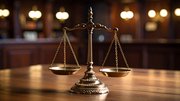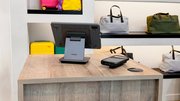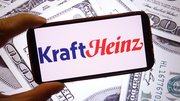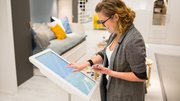Article
ID at your fingertips
Biometric scanners are already incorporated into kiosks in airports, financial institutions, correctional facilities, schools -- even on cruise ships. Consumers are getting comfortable with this technology of the future.
February 17, 2004
Privacy and security. Consumers greatly value both in this age of computerization of personal data. And there are few ways to guarantee either. A self-service unit can identify a user's card, but not the actual user. But biometric scanners can change that.
|
Trevor Prout, director of marketing for the International Biometrics Group, said biometrics is the automated identification or verification of one's identity using physiological clues such as scanning an iris or facial features, hand or fingerprint recognition or handwriting analysis, and matching that information with a database. IBS is a consulting firm that has provided technology-neutral and vendor-independent biometrics services, strategy and solutions to financial institutions, government agencies and high-tech firms since 1996.
Prout said biometric scanners have been incorporated into kiosk designs since he has studied the industry. The most well-known kiosk application concerns border entry. He explained that as more consumers become familiar and comfortable with this government-sponsored technology, it will be used in more mainstream applications.
It is already in place in airports, some financial institutions, correctional facilities, schools -- even on cruise ships.
Head for the border
The tragedy of Sept. 11, 2001, changed so many things in the lives of Americans. And, right or wrong, it changed the way our country looks at foreign-born visitors entering and leaving the United States.
Beginning this month, the U.S. government began fingerprinting and photographing some 23 million foreign visitors with visas arriving at 115 U.S. airports. This is the mandate of the Department of Homeland Security, which runs the United States Visitor and Immigrant Status Indicator Technology, or US-VISIT.
Immigration officials at all U.S. international airports request visitors' passports and visas, and pose the usual security-related questions before taking their fingerprints and photographs.
Surfnet Premiere, the preferred software solutions for public Internet access terminals.
|
US-VISIT will set up self-service kiosks at all U.S. airports. There, visitors will "check out" of the country before stepping on the plane.
Prout said, "There is real incentive for people to use these kiosks. If they don't properly check out of the country, they will have trouble the next time they try to enter."
IR Recognition Systems has had its own version of border-crossing kiosks since 1995. The INS Passenger Accelerated Service System, or INSPASS kiosk, has a HandKey hand-geometry reader. The original purpose of the system was to speed frequent air travelers through U.S. immigration inspection in seconds.
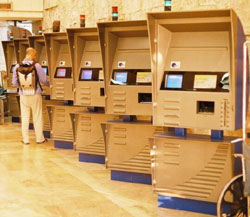 |
Biometric kiosks at Israel's Ben-Gurion International |
The unit enables pre-screened participants to by-pass the long lines that often await in-bound airline passengers, according to Bill Spence, director of marketing at IR Recognition Systems. INSPASS is still in place at airports around the world, and security is a top reason today.
IR Recognition Systems also supplies its hand-reader technology to the State of Washington for its probation system. Spence said the agency has about 70 kiosks used by 16,000 people on probation to report their whereabouts and recent activities.
"Biometrics really change the game," said Spence. "It can be used for anything." He noted that this is especially true since prices have come down on the technology.
A hand-geometry reader starts at about $1,000, while a fingerprint scanner costs about $150 at retail. "This is a small portion of the overall kiosk project," he said.
Financial services
Biometrics already have a place in some financial institutions. RealTime Kiosks has two deployments at Purdue University Employees Credit Union and Y12 Credit Union in Oak Ridge, Tenn. In both deployments, positively matched fingerprints allow users access to accounts.
Scali said, "The whole purpose of biometrics is to replicate what a live teller would do." He said the first thing a teller does is request a form of identification. Once that positive member ID is made, the teller proceeds with transactions.
With a card, a self-serve teller identifies the card, but not the user. For that reason, RealTime Kiosks takes digital photos of the customer at different times during a transaction and compares those photos with ones in the database, to make sure the customer is the same throughout the transaction. Scali explained that a customer can walk away after completing a transaction, unknowingly leaving access to his or her account information on the screen.
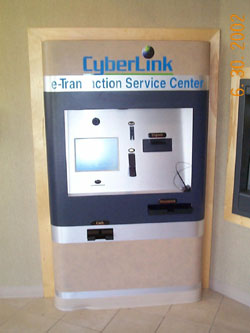 |
Biometric kiosk in lobby of Y12 Credit Union |
This combination of active (fingerprinting) and passive (facial photography) biometrics is essential, Scali said. "Biometrics are good, but they are not perfect. I'd say reliability today is about 98.5 percent. Now that sounds great, but not if you're in that 1.5 percent that the technology doesn't read properly."
At Y12, he explained, all transactions are performed on self-serve kiosks. The credit union is staffed from 8 a.m. to 5 p.m. Customers are allowed controlled access to the kiosks 24x7. "They have found that 65 percent of all transactions are performed after hours," said Scali.
Are biometrics readily accepted by the credit union consumers? "If you just put the kiosk out there and expect them to use it, no," answered Scali. "I'd say don't waste the investment if you're not going to educated users."
Key to privacy
Biometrics are a valuable tool in protecting consumers' privacy. In one application, a kiosk collects health information from school children and the information is locked away by biometrics. A matching fingerprint is the access point for the data.
Bioscrypt Inc. provides the biometric technology for the kiosk, which is in hundreds of K-12 schools in the United States. The goal of the kiosk project is to promote fitness and healthy lifestyles to children.
"We are trying to combat obesity," said Cris Rees, vice president of public relations for the National School Fitness Foundation, a private, non-profit organization that coordinates the "LIFT America" program.
"What we do is track student's lean body mass, and fat body mass to see if our program has an impact on their health and wellness," he said.
The user stands at the kiosk and is prompted to place a finger on the integrated biometric sensor. The user's record is retrieved in real time and displayed on a touchscreen embedded in the kiosk. The student can monitor his or her weight, body fat content, hydration and lean body mass to track progress toward pre-determined fitness goals.
Julia Webb, vice president of global sales and marketing for Bioscrypt Inc., said, "Not only does fingerprint technology secure access to physical-fitness records, it makes fitness fun and interesting for the students."
She said the project is deploying 50 to 100 kiosks each month. The fingerprint module is integrated right into the kiosk.
"The nice thing about tying into a kiosk is that the kiosk already has a processor. We just need a USB device for connecting the module," said Webb.
Biometrics making money?
Biometric devices are a pretty sure thing for protecting kiosk users' identify and personal information, but can they also be used to generate revenue? Carnival Cruise Lines is trying to find out.
The world's largest cruise operator this month began a pilot with biometrics provider, ImageWare Systems Inc., to link digital photo sales with facial-recognition software.
ImageWare will use a combination of its facial-recognition and digital-imaging capabilities to develop a system that will store all professional keepsake photos taken of guests vacationing aboard Carnival Miracle beginning this spring.
To access the system, a guest simply steps up to a standalone photo-retrieval kiosk, which will capture an image of his or her face. This image is then compared, using facial-recognition technology, to all faces in all photos that have been captured on the cruise.
Once the search is complete, photos containing the guest, including group and individual shots, will appear on the screen and be available for review and purchase.
[Editor's note: Info Touch Technologies became Tio Networks in April 2006.]




